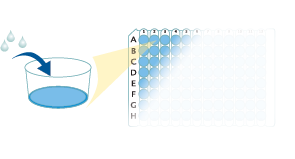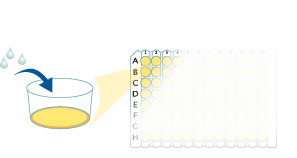Mouse/Rat TNF RI/TNFRSF1A Quantikine ELISA Kit Summary
Product Summary
Precision
Cell Culture Supernates, Serum
| Intra-Assay Precision | Inter-Assay Precision | |||||
|---|---|---|---|---|---|---|
| Sample | 1 | 2 | 3 | 1 | 2 | 3 |
| n | 20 | 20 | 20 | 20 | 20 | 20 |
| Mean (pg/mL) | 46 | 118 | 581 | 48.3 | 120 | 592 |
| Standard Deviation | 2.7 | 6.5 | 27.5 | 2.5 | 6 | 33.3 |
| CV% | 5.9 | 5.5 | 4.7 | 5.2 | 5 | 5.6 |
Recovery
The recovery of TNF RI spiked to levels throughout the range of the assay in various matrices was evaluated.
| Sample Type | Average % Recovery | Range % |
|---|---|---|
| Mouse Cell Culture Supernates (n=5) | 97 | 89-109 |
| Mouse Serum (n=5) | 96 | 83-104 |
| Rat Cell Culture Supernates (n=5) | 98 | 92-116 |
| Rat Serum (n=5) | 96 | 88-104 |
Linearity
Scientific Data
Product Datasheets
Preparation and Storage
Background: TNF RI/TNFRSF1A
TNF RI (TNF receptor 1; TNF R-p55/p60) is a transmembrane receptor for TNF-alpha and Lymphotoxin-alpha/TNF-beta. A soluble decoy form of the receptor is shed by ADAM-17/TACE in response to inflammatory stimulation. TNF RI signaling through NFkB is essential for the development of lymph node germinal centers and Peyer’s patches and for combating intracellular pathogens such as Listeria.
Assay Procedure
Refer to the product- Prepare all reagents, standard dilutions, and samples as directed in the product insert.
- Remove excess microplate strips from the plate frame, return them to the foil pouch containing the desiccant pack, and reseal.
- Add 50 µL of Assay Diluent to each well.
- Add 50 µL of Standard, Control, or sample to each well. Cover with a plate sealer, and incubate at room temperature for 2 hours.
- Aspirate each well and wash, repeating the process 4 times for a total of 5 washes.
- Add 100 µL of Conjugate to each well. Cover with a new plate sealer, and incubate at room temperature for 2 hours.
- Aspirate and wash 5 times.
- Add 100 µL Substrate Solution to each well. Incubate at room temperature for 30 minutes. PROTECT FROM LIGHT.
- Add 100 µL of Stop Solution to each well. Read at 450 nm within 30 minutes. Set wavelength correction to 540 nm or 570 nm.





Citations for Mouse/Rat TNF RI/TNFRSF1A Quantikine ELISA Kit
R&D Systems personnel manually curate a database that contains references using R&D Systems products. The data collected includes not only links to publications in PubMed, but also provides information about sample types, species, and experimental conditions.
31
Citations: Showing 1 - 10
Filter your results:
Filter by:
-
The Autism Spectrum Disorder-Associated Bacterial Metabolite p-Cresol Derails the Neuroimmune Response of Microglial Cells Partially via Reduction of ADAM17 and ADAM10
Authors: Y Zheng, NZ Prince, LN Peralta Ma, S Ahmed, J Garssen, P Perez Pard, AD Kraneveld
International Journal of Molecular Sciences, 2022-09-20;23(19):.
Species: Mouse
Sample Types: Cell Culture Supernates
-
The sodium-glucose cotransporter 2 inhibitor tofogliflozin prevents diabetic kidney disease progression in type 2 diabetic mice
Authors: Z Li, M Murakoshi, S Ichikawa, T Koshida, E Adachi, C Suzuki, S Ueda, T Gohda, Y Suzuki
FEBS Open Bio, 2020-11-10;0(0):.
Species: Mouse
Sample Types: Serum
-
Plasma levels of corticosterone, tumor necrosis factor receptor 1 and interleukin 6 are influenced by age, sex and chronic inflammation in mice treated with acute temperature stress
Authors: N Ge, R Westbrook, J Langdon, H Yang, R Marx, P Abadir, QL Xue, JD Walston
Exp Gerontol, 2020-10-24;142(0):111136.
Species: Mouse
Sample Types: Plasma
-
Translational control of depression-like behavior via phosphorylation of eukaryotic translation initiation factor 4E
Authors: A Aguilar-Va, N Haji, D De Gregori, E Matta-Cama, MJ Eslamizade, J Popic, V Sharma, R Cao, C Rummel, A Tanti, S Wiebe, N Nuñez, S Comai, R Nadon, G Luheshi, N Mechawar, G Turecki, JC Lacaille, G Gobbi, N Sonenberg
Nat Commun, 2018-06-25;9(1):2459.
Species: Mouse
Sample Types: Serum
-
Transfection of bone marrow derived cells with immunoregulatory proteins
Authors: JN Khantakova, AN Silkov, VP Tereshchen, EV Gavrilova, RA Maksyutov, SV Sennikov
Cytokine, 2018-03-24;108(0):82-88.
Species: Mouse
Sample Types: Cell Culture Supernates
-
Murine Nephrotoxic Nephritis as a Model of Chronic Kidney Disease
Authors: MKE Ougaard, PH Kvist, HE Jensen, C Hess, I Rune, H Søndergaar
Int J Nephrol, 2018-03-05;2018(0):8424502.
Species: Mouse
Sample Types: Urine
-
Protective role of cellular prion protein against TNF?-mediated inflammation through TACE ?-secretase
Authors: J Ezpeleta, F Boudet-Dev, M Pietri, A Baudry, V Baudouin, A Alleaume-B, N Dagoneau, O Kellermann, JM Launay, B Schneider
Sci Rep, 2017-08-09;7(1):7671.
Species: Mouse
Sample Types: Cell Culture Supernates
-
Soluble TNF Regulates TACE via AP-2? Transcription Factor in Mouse Dendritic Cells
Authors: L Ge, NL Vujanovic
J. Immunol., 2016-11-16;198(1):417-427.
Species: Mouse
Sample Types: Cell Culture Supernates
-
Macrophage-derived tumor necrosis factor-alpha mediates diabetic renal injury.
Authors: Awad A, You H, Gao T, Cooper T, Nedospasov S, Vacher J, Wilkinson P, Farrell F, Brian Reeves W
Kidney Int, 2015-06-10;88(4):722-33.
Species: Mouse
Sample Types: Tissue Homogenates
-
Dose responsive effects of subcutaneous pentosan polysulfate injection in mucopolysaccharidosis type VI rats and comparison to oral treatment.
Authors: Frohbergh M, Ge Y, Meng F, Karabul N, Solyom A, Lai A, Iatridis J, Schuchman E, Simonaro C
PLoS ONE, 2014-06-25;9(6):e100882.
Species: Rat
Sample Types: Serum
-
Kruppel-like factor 9 deficiency in uterine endometrial cells promotes ectopic lesion establishment associated with activated notch and hedgehog signaling in a mouse model of endometriosis.
Authors: Heard M, Simmons C, Simmen F, Simmen R
Endocrinology, 2014-01-29;155(4):1532-46.
Species: Mouse
Sample Types: Peritoneal Fluid
-
Expression of HIV transgene aggravates kidney injury in diabetic mice.
Authors: Mallipattu S, Liu R, Zhong Y, Chen E, D'Agati V, Kaufman L, Ma'ayan A, Klotman P, Chuang P, He J
Kidney Int, 2013-01-16;83(4):626-34.
Species: Mouse
Sample Types: Serum
-
TNFR2 interposes the proliferative and NF-kappaB-mediated inflammatory response by podocytes to TNF-alpha.
Authors: Bruggeman LA, Drawz PE, Kahoud N, Lin K, Barisoni L, Nelson PJ
Lab. Invest., 2011-01-10;91(3):413-25.
Species: Mouse
Sample Types: Serum
-
Ectodomain shedding of EGFR ligands and TNFR1 dictates hepatocyte apoptosis during fulminant hepatitis in mice.
Authors: Murthy A, Defamie V, Smookler DS
J. Clin. Invest., 2010-07-12;120(8):2731-44.
Species: Mouse
Sample Types: Serum
-
Restoration of regenerative osteoblastogenesis in aged mice: modulation of TNF.
Authors: Wahl EC, Aronson J, Liu L, Fowlkes JL, Thrailkill KM, Bunn RC, Skinner RA, Miller MJ, Cockrell GE, Clark LM, Ou Y, Isales CM, Badger TM, Ronis MJ, Sims J, Lumpkin CK
J. Bone Miner. Res., 2010-01-01;25(1):114-23.
Species: Mouse
Sample Types: Serum
-
Secretory lysosome targeting and induced secretion of human soluble TNF-alpha receptor in murine hematopoietic cells in vivo as a principle for immunoregulation in inflammation and malignancy.
Authors: Johansson AC, Nandakumar KS, Persson AM, Olsson I, Hansson M
Exp. Hematol., 2009-05-30;37(8):969-78.
Species: Mouse
Sample Types: Cell Culture Supernates
-
Fat diet and alcohol-induced steatohepatitis after LPS challenge in mice: role of bioactive TNF and Th1 type cytokines.
Authors: Olleros ML, Martin ML, Vesin D, Fotio AL, Santiago-Raber ML, Rubbia-Brandt L, Spahr L, Hadengue A, Garcia I
Cytokine, 2008-08-22;44(1):118-25.
Species: Mouse
Sample Types: Serum
-
An eosinophil immune response characterizes the inflammatory skin disease observed in Tie-2 transgenic mice.
Authors: Voskas D, Babichev Y, Ling LS, Alami J, Shaked Y, Kerbel RS, Ciruna B, Dumont DJ
J. Leukoc. Biol., 2008-05-01;84(1):59-67.
Species: Mouse
Sample Types: Serum
-
Hypoxia enhances lysosomal TNF-alpha degradation in mouse peritoneal macrophages.
Authors: Lahat N, Rahat MA, Kinarty A, Weiss-Cerem L, Pinchevski S, Bitterman H
Am. J. Physiol., Cell Physiol., 2008-04-23;295(1):C2-12.
Species: Mouse
Sample Types: Cell Culture Supernates
-
Microparticles of human atherosclerotic plaques enhance the shedding of the tumor necrosis factor-alpha converting enzyme/ADAM17 substrates, tumor necrosis factor and tumor necrosis factor receptor-1.
Authors: Canault M, Leroyer AS, Peiretti F, Leseche G, Tedgui A, Bonardo B, Alessi MC, Boulanger CM, Nalbone G
Am. J. Pathol., 2007-09-14;171(5):1713-23.
Species: Mouse
Sample Types: Cell Culture Supernates
-
Differential roles of p55 and p75 tumor necrosis factor receptors on stretch-induced pulmonary edema in mice.
Authors: Wilson MR, Goddard ME, O'Dea KP, O'Dea KP, Choudhury S, Takata M
Am. J. Physiol. Lung Cell Mol. Physiol., 2007-04-13;293(1):L60-8.
Species: Mouse
Sample Types: BALF
-
Bacterial translocation is downregulated by anti-TNF-alpha monoclonal antibody administration in rats with cirrhosis and ascites.
Authors: Frances R, Chiva M, Sanchez E, Gonzalez-Navajas JM, Llovet T, Zapater P, Soriano G, Munoz C, Balanzo J, Perez-Mateo M, Song XY, Guarner C, Such J
J. Hepatol., 2006-12-27;46(5):797-803.
Species: Rat
Sample Types: Serum
-
The shedding activity of ADAM17 is sequestered in lipid rafts.
Authors: Tellier E, Rebsomen L
Exp. Cell Res., 2006-09-05;312(20):3969-80.
Species: Mouse, Rat
Sample Types: Cell Lysates, Tissue Homogenates
-
FHL2 interacts with both ADAM-17 and the cytoskeleton and regulates ADAM-17 localization and activity.
Authors: Canault M, Tellier E, Bonardo B, Mas E, Aumailley M, Juhan-Vague I, Nalbone G, Peiretti F
J. Cell. Physiol., 2006-08-01;208(2):363-72.
Species: Mouse
Sample Types: Cell Lysates
-
Nrf2 is a critical regulator of the innate immune response and survival during experimental sepsis.
Authors: Thimmulappa RK, Lee H, Rangasamy T, Reddy SP, Yamamoto M, Kensler TW, Biswal S
J. Clin. Invest., 2006-04-01;116(4):984-95.
Species: Mouse
Sample Types: Serum
-
Role of tumour necrosis factor-alpha receptor p75 in cigarette smoke-induced pulmonary inflammation and emphysema.
Authors: D'hulst AI, Bracke KR, Maes T, De Bleecker JL, Pauwels RA, Joos GF, Brusselle GG
Eur. Respir. J., 2006-03-15;28(1):102-12.
Species: Mouse
Sample Types: BALF
-
Systemic up-regulation of sTNFR2 and IL-6 in Porphyromonas gingivalis pneumonia in mice.
Authors: Petelin M, Naruishi K, Shiomi N, Mineshiba J, Arai H, Nishimura F, Takashiba S, Murayama Y
Exp. Mol. Pathol., 2004-02-01;76(1):76-81.
Species: Human
Sample Types: Serum
-
A critical role for CCR2/MCP-1 interactions in the development of idiopathic pneumonia syndrome after allogeneic bone marrow transplantation.
Authors: Hildebrandt GC, Duffner UA, Olkiewicz KM, Corrion LA, Willmarth NE, Williams DL, Clouthier SG, Hogaboam CM, Reddy PR, Moore BB, Kuziel WA, Liu C, Yanik G, Cooke KR
Blood, 2003-11-13;103(6):2417-26.
Species: Mouse
Sample Types: BALF
-
First-generation adenovirus vectors shorten survival time in a murine model of sepsis.
Authors: Doerschug K, Sanlioglu S, Flaherty DM, Wilson RL, Yarovinsky T, Monick MM, Engelhardt JF, Hunninghake GW
J. Immunol., 2002-12-01;169(11):6539-45.
Species: Mouse
Sample Types: Serum
-
The protein tyrosine kinase inhibitor AG126 prevents the massive microglial cytokine induction by pneumococcal cell walls.
Authors: Hanisch UK, Prinz M, Angstwurm K, Hausler KG, Kann O, Kettenmann H, Weber JR
Eur. J. Immunol., 2001-07-01;31(7):2104-15.
Species: Mouse
Sample Types: Cell Culture Supernates
-
Enhanced murine macrophage TNF receptor shedding by cytosine-guanine sequences in oligodeoxynucleotides.
Authors: Jin L, Raymond DP, Crabtree TD, Pelletier SJ, Houlgrave CW, Pruett TL, Sawyer RG
J. Immunol., 2000-11-01;165(9):5153-60.
Species: Mouse
Sample Types: Cell Culture Supernates
FAQs
No product specific FAQs exist for this product, however you may
View all ELISA FAQsReviews for Mouse/Rat TNF RI/TNFRSF1A Quantikine ELISA Kit
There are currently no reviews for this product. Be the first to review Mouse/Rat TNF RI/TNFRSF1A Quantikine ELISA Kit and earn rewards!
Have you used Mouse/Rat TNF RI/TNFRSF1A Quantikine ELISA Kit?
Submit a review and receive an Amazon gift card.
$25/€18/£15/$25CAN/¥75 Yuan/¥2500 Yen for a review with an image
$10/€7/£6/$10 CAD/¥70 Yuan/¥1110 Yen for a review without an image








